| THAP7 |
|---|
|
| Identifiers |
|---|
| Aliases | THAP7, THAP domain containing 7 |
|---|
| External IDs | OMIM: 609518; MGI: 1916259; HomoloGene: 12293; GeneCards: THAP7; OMA:THAP7 - orthologs |
|---|
| Gene location (Human) |
|---|
 | | Chr. | Chromosome 22 (human)[1] |
|---|
| | Band | 22q11.21 | Start | 20,999,104 bp[1] |
|---|
| End | 21,002,196 bp[1] |
|---|
|
| Gene location (Mouse) |
|---|
 | | Chr. | Chromosome 16 (mouse)[2] |
|---|
| | Band | 16 A3|16 | Start | 17,345,846 bp[2] |
|---|
| End | 17,349,000 bp[2] |
|---|
|
| RNA expression pattern |
|---|
| Bgee | | Human | Mouse (ortholog) |
|---|
| Top expressed in | - anterior pituitary
- right testis
- muscle of thigh
- left testis
- apex of heart
- gastric mucosa
- gastrocnemius muscle
- left uterine tube
- right lobe of liver
- gonad
|
| | Top expressed in | - fossa
- internal carotid artery
- primary oocyte
- external carotid artery
- motor neuron
- condyle
- spermatocyte
- proximal tubule
- right kidney
- spermatid
|
| | More reference expression data |
|
|---|
| BioGPS |  | | More reference expression data |
|
|---|
|
| Gene ontology |
|---|
| Molecular function | - DNA binding
- C2H2 zinc finger domain binding
- protein binding
- metal ion binding
- protein N-terminus binding
- nucleic acid binding
- identical protein binding
- DNA-binding transcription factor activity, RNA polymerase II-specific
| | Cellular component | - nuclear speck
- chromosome
- nucleus
- nuclear membrane
- intracellular membrane-bounded organelle
| | Biological process | - negative regulation of transcription, DNA-templated
- regulation of transcription, DNA-templated
- transcription, DNA-templated
- regulation of transcription by RNA polymerase II
| | Sources:Amigo / QuickGO |
|
| Orthologs |
|---|
| Species | Human | Mouse |
|---|
| Entrez | | |
|---|
| Ensembl | | |
|---|
| UniProt | | |
|---|
| RefSeq (mRNA) | |
|---|
NM_030573
NM_001008695
NM_001008696 |
| |
|---|
| RefSeq (protein) | | |
|---|
| Location (UCSC) | Chr 22: 21 – 21 Mb | Chr 16: 17.35 – 17.35 Mb |
|---|
| PubMed search | [3] | [4] |
|---|
|
| Wikidata |
| View/Edit Human | View/Edit Mouse |
|


















